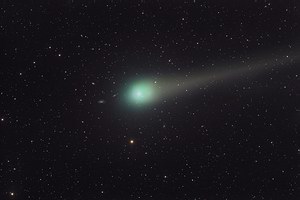Comet Lulin has been a fast moving object at 0.22 degree per hour on Feb 28, 2009. When trying to preserve the information of the star background and to get a clean image of the comet's nucleus the comet has to be extracted from the image by special processing steps. Comet and background have be aligned seperately regarding luminance and color information.
To have less troubles during processing I recommend to take an RGB set at the beginning, then taking a set of 15-30 L frames and at the end again one set of RGB frames.
The optimum exposure time for each frame depends on the speed of the comet and the focal lenght of the setup.
A single 5 min stretched L frame already can go quite deep with not too much trailing at 1 m focal lenght, checkout a single L frame to the right
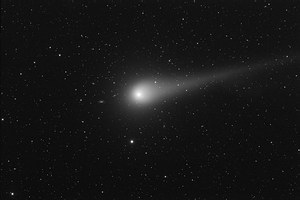
First after calibrating all L images the first set was aligned on the comet's nucleus (using Imagesplus, that is good for a large set of data). Then the set was median combined with Poisson outlier reject in CCDstack. The result is a clean image with only the comet showing up, see the stretched version to the right
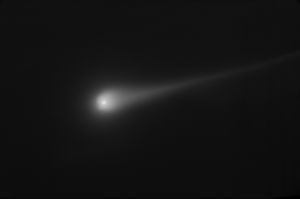
In another folder all 25 L raws were aligned on the stars and a mean combine image in CCDstack was performed, the result is showing objects down to mag 20 and exhibits a good S/N ratio even for the dim parts, checkout the combined image to the right
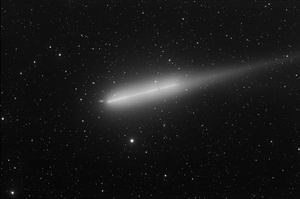
This image shows all the details outside the comet area in best S/N ratio.
A new procedure was executed in Photoshop to extract the star field:
To reconstruct the background area of the comet I "substracted" from each single stretched star aligned raw the median comet image with adjusting the black side of levels to have a complete elimination of the comet, as you see to the right
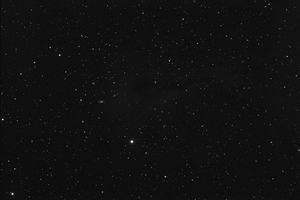
25 of these cleaned images were produced to combine them as mean stack.
Then again the median comet part was added at the exact timeline position of the RGB image and was additionally overlayed with the mean image regarding the outer areas.
The color information was handled completely differently. The star aligned RGB image was stretched in Photoshop.
Then the Halo of the comet was selected first for the blue channel, copy and paste into the same channel, the eye checked for RGB to see all the RGB but still with only the blue channel active, this should look like this
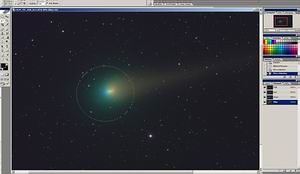
Then the halo part is moved to the right until the nucleus is aligned with the green channel. The same procedure is done with the red channel moving the selected area to the left to match with the green channel, the result should look like this
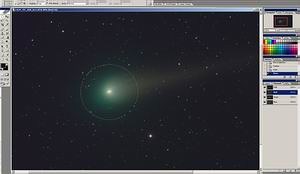
The coma is ok for the color, the inner color shifted stars have to be treated manually. The blue and red stars are stamped away using the information from the closeby area with the clone tool.
To restore the original color information from the green stars within the coma I pasted in the original stretched RGB image, added a "hide all" layer mask and revealed just the star information where required with the white brush. To improve the S/N some smoothing was applied to the RGB.
Then very gently (5% wise) the b/w composite was incorporated into the color image as luminance in 10 steps while increasing the saturation after each flattening.
The final result you find to the right (link)
